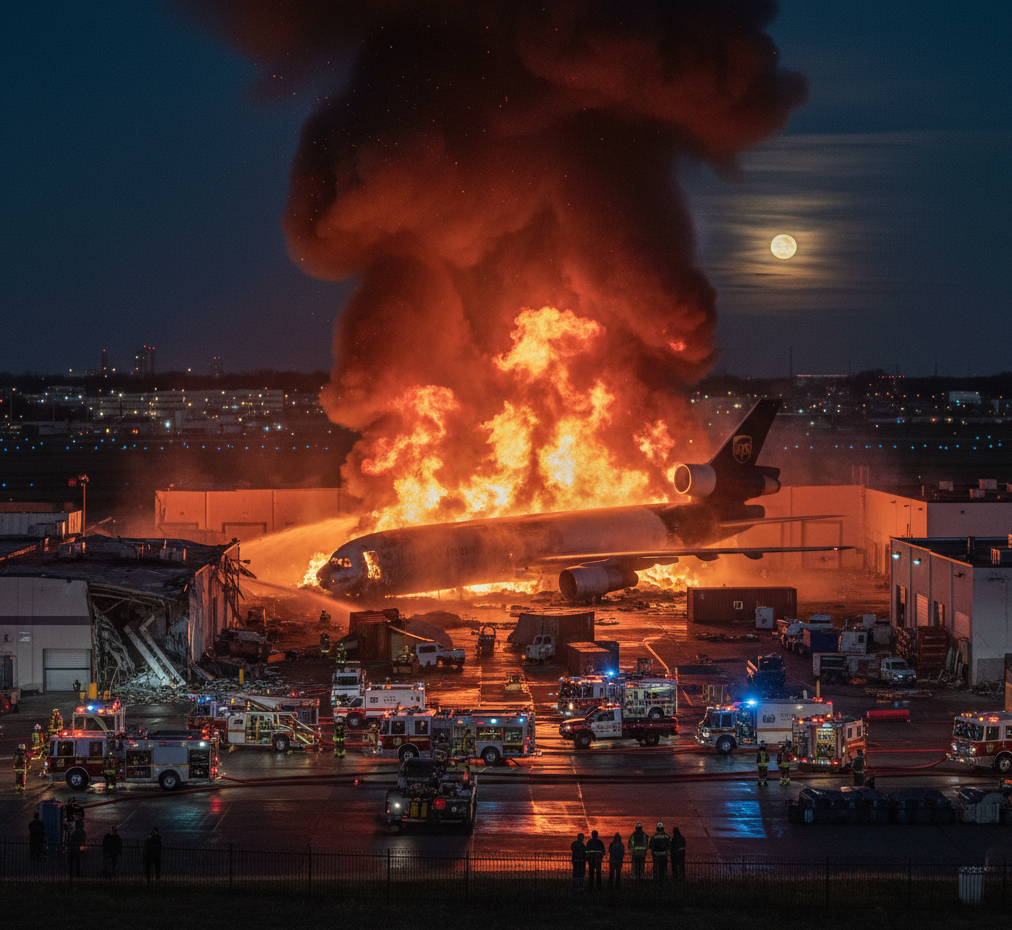Small Plane Crash on Powers Boulevard in Colorado Springs: Three Occupants Walk Away Unharmed
In the early morning hours of October 1st, residents of Colorado Springs witnessed a remarkable event that could have ended in tragedy but instead became a testament to quick thinking, emergency preparedness, and extraordinary luck. A small single-engine aircraft made an emergency landing on one of the city’s busiest thoroughfares, yet miraculously, everyone involved walked away without a scratch. This incident serves as both a reminder of aviation’s inherent risks and a celebration of the robust emergency response systems that protect our communities.
I. The Morning Incident and Emergency Response
A. A Forced Landing on a Major Thoroughfare
The accident occurred just after 4:00 AM on October 1st, near the intersection of North Powers Boulevard and Barnes Road. The aircraft involved was a Piper PA-28, a popular single-engine plane commonly used for flight training and personal aviation. The pilot had departed from Colorado Springs Airport with two passengers aboard, embarking on what should have been a routine flight.
However, barely five minutes into the journey, the pilot reported mechanical difficulties to air traffic control. In aviation, the first five minutes after takeoff represent one of the most critical phases of flight, as the aircraft is still climbing and has limited altitude to maneuver in case of emergency. Faced with rapidly deteriorating conditions and limited options, the pilot made the split-second decision to attempt an emergency landing on Powers Boulevard, one of Colorado Springs’ main north-south arteries.
The choice of Powers Boulevard, while unusual, likely saved lives. The wide roadway provided more landing space than many alternatives, and the early morning hour meant traffic was relatively light compared to later in the day. Aviation experts later noted that the pilot’s decision-making under pressure demonstrated excellent judgment and training. Emergency landings on public roads are incredibly rare, occurring only when pilots have exhausted all other viable options.
Witnesses reported hearing the aircraft’s engine sputtering before the landing. One early morning commuter described seeing the plane descending rapidly with its landing lights illuminated, giving drivers precious seconds to react. The pilot managed to maintain control throughout the descent, a feat that requires exceptional skill given the challenging circumstances.
B. The Miraculous Outcome
Remarkably, all three individuals aboard the aircraft emerged from the wreckage without any injuries. The Colorado Springs Police Department (CSPD) arrived on scene within minutes and confirmed that no one on the ground was harmed either. This outcome is particularly noteworthy considering the potential for catastrophic consequences when aircraft encounter problems over populated areas.
The plane did strike several utility poles during its descent, causing brief power disruptions in the immediate vicinity. However, the surrounding structures remained intact, and no fires erupted despite the aircraft’s fuel load. Emergency medical technicians evaluated all three occupants at the scene, but none required hospitalization. The pilot, whose identity has not been publicly released pending the investigation, was visibly shaken but coherent and cooperative with authorities.
Local aviation safety experts called the outcome “nothing short of miraculous.” Statistics show that forced landings, particularly in urban environments, carry significant risk. The fact that this incident resulted in zero injuries speaks to multiple factors aligning favorably: the pilot’s skill, the aircraft’s relatively slow landing speed, the early morning timing, and the quick response of emergency services.
II. Risk Management and Scene Containment
A. The Urgency of Fuel Leakage
Upon landing, the aircraft immediately began leaking aviation fuel, creating an extremely dangerous situation. Aviation gasoline is highly flammable, and the presence of sparks from damaged electrical systems or even static electricity could have triggered a devastating fire or explosion. The Colorado Springs Fire Department (CSFD) arrived within seven minutes of the initial 911 calls and immediately began containment procedures.
Firefighters established a wide safety perimeter around the crash site, keeping curious onlookers and media at a safe distance. Specialized hazardous materials teams deployed absorbent materials to contain the fuel spill, preventing it from entering storm drains or contaminating nearby soil and water sources. The environmental impact was a secondary but important concern, as aviation fuel contains toxic compounds that can harm ecosystems.
Fire crews also monitored the aircraft’s battery and electrical systems, which posed additional fire risks. The team worked methodically to disconnect power sources and ensure the wreckage was completely stabilized before allowing investigators near the scene. Captain Jennifer Martinez of the CSFD later stated, “Our primary concern was preventing a secondary incident. Fuel leaks in combination with damaged electrical systems create perfect conditions for fire, and we weren’t taking any chances.”
The fuel containment operation lasted approximately three hours, with crews using specialized foam and absorbent pads to neutralize the hazard. Environmental specialists were called to assess soil contamination levels, and preliminary tests showed minimal environmental impact thanks to the rapid response.
B. Major Traffic Disruptions
The incident occurred during the early stages of the morning rush hour, causing significant traffic disruptions throughout the northeastern portion of Colorado Springs. Two southbound lanes of Powers Boulevard were immediately closed, creating a bottleneck that affected thousands of commuters. The closure extended from Dublin Boulevard to Stetson Hills Boulevard, a stretch of approximately two miles.
The CSPD and CSFD jointly advised residents to avoid the area entirely and seek alternate routes. Morning commuters faced delays of up to forty-five minutes as traffic was rerouted through residential neighborhoods. The intersection of Powers Boulevard and Barnes Road, normally one of the busiest in the city during morning hours, was completely shut down to all through traffic.
Traffic management became a significant operation in itself, requiring coordination between multiple agencies. Officers directed vehicles to alternate routes including Marksheffel Road and Woodmen Road, both of which experienced unusual congestion as a result. Local businesses near the crash site were temporarily inaccessible, affecting both employees and customers.
Electronic message boards throughout the city displayed warnings about the incident, and local news stations provided continuous updates on alternate routes. The Colorado Department of Transportation deployed additional personnel to manage the traffic flow and prevent secondary accidents caused by the unusual congestion patterns.
III. The Federal Investigation and Cleanup Process
A. Role of the FAA and Cause Determination
The Federal Aviation Administration (FAA) was notified immediately and dispatched investigators to the scene within hours. The National Transportation Safety Board (NTSB) was also informed, as federal law requires their involvement in all civil aviation accidents. These agencies bring specialized expertise in aircraft accident investigation, examining everything from mechanical systems to pilot decision-making.
The investigation process is thorough and methodical. Investigators began by documenting the crash site with photographs and measurements, creating a detailed record of the aircraft’s final position and the distribution of debris. They examined flight logs, maintenance records, and the pilot’s certification and medical records. The aircraft’s engine, being the likely source of the reported mechanical problems, received particular attention.
Preliminary reports suggested that a mechanical failure may have contributed to the sudden descent. Investigators focused on the engine’s fuel delivery system, ignition components, and control linkages. The Piper PA-28 is generally considered a reliable aircraft with decades of proven service, making this incident particularly noteworthy. Maintenance logs showed the aircraft had recently undergone its required annual inspection, adding another layer of complexity to the investigation.
The pilot provided a detailed account of the incident, describing unusual engine vibrations followed by a sudden loss of power. This testimony, combined with physical evidence from the wreckage, will help investigators piece together the exact sequence of events. The FAA emphasized that determining the precise cause could take several weeks or even months, as they conduct laboratory analysis of critical components.
B. Clearing Process
The cleanup operation presented its own set of challenges. Removing an aircraft from a major urban roadway requires specialized equipment and expertise. The wreckage needed to be transported to a secure facility where investigators could conduct their examination without interference or contamination of evidence.
The tow truck capable of handling the aircraft was located in Denver, approximately seventy miles north of Colorado Springs. Coordinating its arrival, securing the necessary permits for oversized load transport, and planning the safest route all contributed to delays in reopening Powers Boulevard. Officials could not provide an estimated time of arrival initially, frustrating commuters who hoped for a quick resolution.
Beyond simply removing the aircraft, crews needed to address fuel contamination and restore damaged infrastructure. Several utility poles required replacement, and the road surface itself sustained damage from the impact and subsequent emergency response vehicles. Colorado Springs Utilities dispatched teams to assess and repair electrical distribution systems affected by the damaged poles.
Environmental remediation specialists collected soil samples from areas where fuel had contacted the ground. These samples were sent to laboratories for analysis to determine whether additional cleanup measures were necessary. The city’s environmental services department monitored the situation closely to ensure compliance with all applicable regulations.
IV. Community Reflections and Resilience
A. Relief at the Outcome
The Colorado Springs community responded with an outpouring of relief and gratitude on social media platforms. Residents praised the quick actions of emergency response teams and expressed amazement that the incident resulted in no injuries. Many commenters noted how different the outcome could have been had the plane crashed just a few hours later when traffic volume would have been substantially higher.
Local pilot organizations also weighed in, commending the pilot’s handling of an extremely stressful and dangerous situation. The ability to successfully execute an emergency landing on a roadway demonstrates both excellent training and remarkable composure under pressure. Several flight instructors used the incident as a teaching moment, discussing emergency procedures with their students and emphasizing the importance of maintaining proficiency in forced landing techniques.
Community members who witnessed the aftermath described feelings of disbelief mixed with gratitude. One nearby resident stated, “I heard the sirens and saw all the emergency lights. When I found out it was a plane crash with no injuries, I couldn’t believe it. We’re so fortunate that everyone is okay.” This sentiment was echoed throughout the community, with many expressing renewed appreciation for the city’s emergency services.
B. Lessons on Urban Safety
The absence of injuries highlights the effectiveness of local emergency protocols and the importance of coordinated response systems. Colorado Springs has invested significantly in emergency preparedness training and equipment, and this incident validated those investments. The seamless coordination between police, fire, medical, and federal aviation authorities demonstrated a well-oiled emergency response machine.
While local officials emphasized that such events are extremely rare, the incident serves as a reminder of life’s unpredictable nature and the critical importance of preparedness. Aviation accidents in urban areas, though uncommon, require unique response capabilities that differ from typical emergency scenarios. The ability of Colorado Springs emergency services to quickly contain hazards, manage traffic, and coordinate with federal investigators showcased their professionalism and training.
This event also sparked discussions about urban aviation safety. Colorado Springs is home to a busy municipal airport, military installations, and significant air traffic. While the safety record of general aviation remains strong, this incident reminded residents that aircraft operate overhead daily. City planners and aviation officials will likely review this incident to identify any potential improvements to emergency response procedures or flight path management.
The resilience shown by the Colorado Springs community in responding to this unusual event reflects the city’s character and preparedness. From the pilot’s skilled emergency landing to the efficient work of first responders and the patience of affected commuters, everyone involved contributed to the best possible outcome under challenging circumstances. As the investigation continues and normal traffic patterns resume, this incident will be remembered not for tragedy, but for the remarkable convergence of skill, luck, and preparedness that ensured everyone went home safely that morning.
Small plane crash-lands on Powers Boulevard in Colorado …
Small-engine aircraft crashes on Powers Blvd.
Colorado Springs Plane Crash Disrupts Morning Commute …
No injuries reported after plane makes crash landing in …




